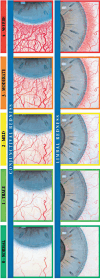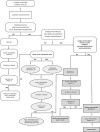Brazilian guidelines for the monitoring and treatment of pediatric allergic conjunctivitis
- PMID: 34852049
- PMCID: PMC11878402
- DOI: 10.5935/0004-2749.20220053
Brazilian guidelines for the monitoring and treatment of pediatric allergic conjunctivitis
Abstract
Allergic conjunctivitis is an increasingly frequent condition with a higher prevalence in children. It can be debilitating and is responsible for a great economic burden. These guidelines were developed on the basis of the medical literature (PubMed/Medline database) and the experience of an Expert Committee composed of members of the Brazilian Society of Pediatric Ophthalmology, the Brazilian Council of Ophthalmology, the Brazilian Society of Pediatrics, and the Brazilian Association of Allergy and Immunology. Allergic conjunctivitis is considered to be controlled when the ocular symptoms are not uncomfortable or are present, at most, on 2 days a week; the visual analog scale score is below 5; and the degree of conjunctival hyperemia is graded 0 or 1 on the Efron scale. Allergic conjunctivitis should be classified as mild, moderate, severe, and vision-threatening for adequate treatment and monitoring of frequency. The present document is a guideline for diagnosing, treating, and monitoring pediatric allergic conjunctivitis considering the clinical and demographic aspects of allergic conditions in Brazil.
A conjuntivite alérgica (CA) é uma condição frequente, debilitante e responsável por grande impacto econômico, proporcionalmente maior quando acomete crianças. Essas diretrizes foram desenvolvidas com base na literatura científica (PubMed/Medline) e na experiência de um Comitê de Especialistas composto por membros da Sociedade Brasileira de Oftalmologia Pediátrica, do Conselho Brasileiro de Oftalmologia, da Sociedade Brasileira de Pediatria e da Associação Brasileira de Alergia e Imunologia. A conjuntivite alérgica é considerada controlada quando os sintomas não são desconfortáveis ou estão presentes por dois dias na semana; o escore visual pela escala analógica é inferior a 5 e o grau de hiperemia conjuntival é de 0-1 pela escala de Efron. A conjuntivite alérgica deve ser classificada em leve, moderada, grave e com risco de perda visual para tratamento e frequência de monitoramento adequados. Esta diretriz orienta o diagnóstico, tratamento e monitoramento da conjuntivite alérgica pediátrica, considerando aspectos clínicos e demográficos das condições alérgicas no Brasil.
Conflict of interest statement
Figures
Similar articles
-
Epidemiology of allergic conjunctivitis: clinical appearance and treatment patterns in a population-based study.Curr Opin Allergy Clin Immunol. 2015 Oct;15(5):482-8. doi: 10.1097/ACI.0000000000000204. Curr Opin Allergy Clin Immunol. 2015. PMID: 26258920 Review.
-
Guideline on allergen-specific immunotherapy in IgE-mediated allergic diseases: S2k Guideline of the German Society for Allergology and Clinical Immunology (DGAKI), the Society for Pediatric Allergy and Environmental Medicine (GPA), the Medical Association of German Allergologists (AeDA), the Austrian Society for Allergy and Immunology (ÖGAI), the Swiss Society for Allergy and Immunology (SGAI), the German Society of Dermatology (DDG), the German Society of Oto- Rhino-Laryngology, Head and Neck Surgery (DGHNO-KHC), the German Society of Pediatrics and Adolescent Medicine (DGKJ), the Society for Pediatric Pneumology (GPP), the German Respiratory Society (DGP), the German Association of ENT Surgeons (BV-HNO), the Professional Federation of Paediatricians and Youth Doctors (BVKJ), the Federal Association of Pulmonologists (BDP) and the German Dermatologists Association (BVDD).Allergo J Int. 2014;23(8):282-319. doi: 10.1007/s40629-014-0032-2. Allergo J Int. 2014. PMID: 26120539 Free PMC article.
-
Time to onset and duration of action of the antihistamine bepotastine besilate ophthalmic solutions 1.0% and 1.5% in allergic conjunctivitis: a phase III, single-center, prospective, randomized, double-masked, placebo-controlled, conjunctival allergen challenge assessment in adults and children.Clin Ther. 2009 Sep;31(9):1908-21. doi: 10.1016/j.clinthera.2009.09.001. Clin Ther. 2009. PMID: 19843481 Clinical Trial.
-
[Clinical study of Supranettes pads in the treatment of seasonal or perennial allergic conjunctivitis in children].J Fr Ophtalmol. 2006 Jun;29(6):593-8. doi: 10.1016/s0181-5512(06)73819-0. J Fr Ophtalmol. 2006. PMID: 16885888 Clinical Trial. French.
-
Diagnosing and managing allergic conjunctivitis in childhood: The allergist's perspective.Pediatr Allergy Immunol. 2019 Jun;30(4):405-414. doi: 10.1111/pai.13035. Pediatr Allergy Immunol. 2019. PMID: 30742722 Review.
Cited by
-
V Brazilian Consensus on Rhinitis - 2024.Braz J Otorhinolaryngol. 2025 Jan-Feb;91(1):101500. doi: 10.1016/j.bjorl.2024.101500. Epub 2024 Sep 7. Braz J Otorhinolaryngol. 2025. PMID: 39388827 Free PMC article. Review.
-
Comparison of obstructive sleep apnea syndrome and keratoconus patients on elevation maps.Int Ophthalmol. 2022 Mar;42(3):933-938. doi: 10.1007/s10792-021-02074-8. Epub 2021 Oct 18. Int Ophthalmol. 2022. PMID: 34661795
-
Comparison of olopatadine with ketotifen for allergic conjunctivitis: a meta-analysis study.Postepy Dermatol Alergol. 2023 Apr;40(2):326-330. doi: 10.5114/ada.2023.127647. Epub 2023 May 31. Postepy Dermatol Alergol. 2023. PMID: 37312902 Free PMC article.
References
-
- Japanese Ocular Allergology S . Guidelines for the clinical manage-ment of allergic conjunctival disease. 2nd. 10. Vol. 114. Nippon Ganka Gakkai Zasshi; 2010. pp. 831–870. Japanese. - PubMed
-
- Krachmer JH, Mannis MJ, Holland EJ. Cornea. 3rd. Philadelphia: Elsevier/Mosby; 2010.
-
- Geraldini M, Chong Neto HJ, Riedi CA, Rosário NA. Epidemiology of ocular allergy and co-morbidities in adolescents. J Pediatr (Rio J) 2013;89(4):354–360. - PubMed
-
- Solé D, Rosário Filho NA, Sarinho ES, Camelo-Nunes IC, Barreto BA, Medeiros ML, et al. Prevalence of asthma and allergic diseases in adolescents: nine-year follow-up study (2003-2012) J Pediatr (Rio J) 2015;91(1):30–35. - PubMed
-
- Neto HJ, Rosário NA, Westphal GL, Riedi CA, Santos HL. Allergic conjunctivitis in asthmatic children: as common as underreported. Ann Allergy Asthma Immunol. 2010;105(5):399–400. - PubMed
MeSH terms
LinkOut - more resources
Full Text Sources



